NCERT Solutions For Class 4 Maths Chapter 3 - A Trip to Bhopal
The chapter A Trip to Bhopal deals with the concept of estimation and word problems on addition, subtraction, and multiplication through the story of a trip in which a group of children are going to Bhopal by a bus.
Download PDF For NCERT Solutions for Maths A Trip to Bhopal
The NCERT Solutions For Class 4 Maths Chapter 3 - A Trip to Bhopal are tailored to help the students master the concepts that are key to success in their classrooms. The solutions given in the PDF are developed by experts and correlate with the CBSE syllabus of 2023-2024. These solutions provide thorough explanations with a step-by-step approach to solving problems. Students can easily get a hold of the subject and learn the basics with a deeper understanding. Additionally, they can practice better, be confident, and perform well in their examinations with the support of this PDF.
Download PDF
Access Answers to NCERT Solutions For Class 4 Maths Chapter 3 - A Trip to Bhopal
Students can access the NCERT Solutions For Class 4 Maths Chapter 3 - A Trip to Bhopal. Curated by experts according to the CBSE syllabus for 2023–2024, these step-by-step solutions make Maths much easier to understand and learn for the students. These solutions can be used in practice by students to attain skills in solving problems, reinforce important learning objectives, and be well-prepared for tests.
A trip to Bhopal
So, there are a total of __________ children going.
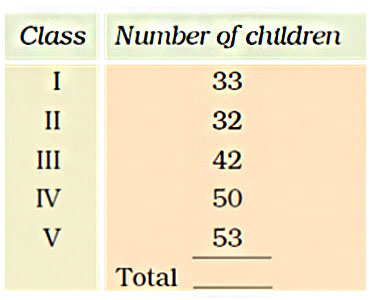
Add the students of every class to get the total number of children going to Bhopal.
33 + 32 + 42 + 50 + 53 = 210
So, there are a total of 210 children going.
If they get 4 buses, how many children will get seats?
In one bus 50 children can be seated. Multiply 4 by 50 to get the number of children that will get seats in 4 buses.
4 × 50 = 200
Therefore, 200 children will get seats in 4 buses.
Will there be any children left without seats?
The total number of children going to Bhopal is 210. The number of children that will get seats in 4 buses is 200.
Subtract 200 from 210 to get the number of children without the seats.
210 – 200 = 10
Therefore, 10 children will be without seats.
Each mini bus can take 35 students. How many mini buses are needed?
The total number of students is 210. Number of students each mini bus can take is 35.
Divide 210 by 35 to get the number of mini buses needed.
210 ÷ 35 = 6
Therefore, 6 mini buses are needed.
If we don’t stop anywhere, we should reach there in 2 hours, which is around ______ o’ clock.
The journey begins at 9 o’clock. It will take 2 hours to reach Bhopal. Therefore, they should reach there around 11 o’ clock.
If they go to Bhimbetka, they will there:
- Before 10 o’ clock
- Between 10 o’clock and 11 o’ clock
- After 11 o’ clock
Time required to reach Bhopal is 2 hours. If they start the journey at 9 o’ clock then they will reach Bhopal at around 11 o’ clock.
The distance of Bhopal is 70 km. Therefore, the time required to reach half the distance of Bhopal that is 35 km should be 1 hour which is at around 10 o’ clock.
The distance of Bhimbetka is 50 km which is more than 35 km. Therefore, they should take more than 1 hour to reach there which is between 10 o’ clock and 11 o’ clock.
Hence, the second option is the correct answer.
Was Victoria, right?
The relation between kilometres and metres is: 1 km = 1000 m.
Therefore, half kilometre is equal to 500 metres.
The length of the River Narmada is 756.82 metres which is more than half kilometre. Therefore, the width of the river Narmada should be approximately half kilometre. Hence, Victoria was right.
Have you ever crossed a long bridge? About how many metres long was it? __________
Think about the places you have visited and answer this question by yourself.
There is Howrah Bridge in West Bengal, that is 705 metres long.
What is the difference between the water level of the Narmada in the rainy season and now? _______ metres.
The present water level is 40 metres below the bridge. In rainy season the water level is 15 metres below the bridge. Subtract 15 from 40 to obtain the difference.
40 – 15 = 25
Hence, the difference between the water level of the Narmada in the rainy season and now is 25 metres below the sea level
Each bus takes about 15 minutes to refill and there are two busses to be refilled. So, they stop there for about _______ minutes, which means they are late by about ______ minutes.
The time taken to refill one bus is 15 minutes. Therefore, the time taken to refill two buses will be:
15 + 15 = 30 minutes.
So, they stop there for about 30 minutes, which means they are late by about 30 minutes.
Look in the picture and find the price of 1 litre of diesel. _______
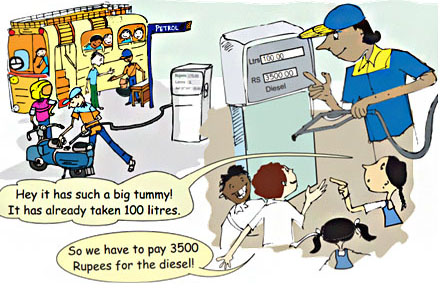
It is observed from the picture that the price of 100 litres of diesel is Rs 3500.
Divide 3500 by 100 to get the price of 1 litre of diesel.
3500 ÷ 100 = 35
Therefore, the price of 1 litre of diesel is Rs 35.
How much time did Aman take to come out of the toilet? ______
Time required to refill one bus is 15 minutes which is same as the time taken by Aman.
Therefore, Aman took 15 minutes to come out of the toilet.
How many more deer are there than bison? __________
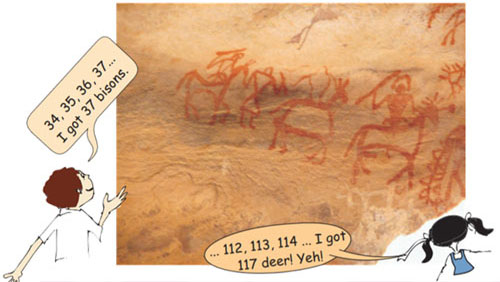
Total number of bison are 37. Total number of deer are 117.
Subtract 37 from 117 to get the difference. 117 – 37 = 80
Therefore, there were 80 more deer than the bison.
How many people must Bonomala have counted? 214 / 154 / 134 / 177
Add 37 and 117 to get the total numbers of deer and the bison together.
37 + 117 = 154
The number of people should be more than 154 but less than 200. Therefore, Bonomala must have counted 177 people.
They have spent 1 hour there. What time is it? ______
They are now moving towards Bhopal. They should reach there in less than 1 hour, at about ______ o’clock.
They reach Bhimbetka at around 11 o’ clock and spend 1 hour there. It is around 12 o’ clock. They should reach Bhopal in less than 1 hour, at about 1 o’ clock.
How many oranges, biscuits and banana are distributed?
Step 1: The total number of children is 210. Each child has taken 1 orange. Therefore, 210 oranges are distributed.
Step 2: 38 children have not taken banana. Subtract 38 from 210 to get the number of bananas distributed. 210 – 38 = 172
Step 3: Each child has taken 5 biscuits. Multiply 210 by 5 to get the number of biscuits distributed. 210 × 5 = 1050 Therefore, 210 oranges, 172 bananas, and 1050 biscuits were distributed.
I gave four toffees each to four of my friends and three toffees are left with me. How many toffees did I have?
Step 1: Number of toffees given to each friend is 4. Number of friends is 4.
Multiply 4 by 4 to get the total toffees given.
4 × 4 = 16
Step 2: Number of toffees left is 3. Add 16 and 3 to get the total toffees.
16 + 3 = 19
Therefore, I had 19 toffees.
What numbers can you make using 3, 5, and 7? You can make 357 and 537. What others?
Different three-digit numbers can be made by using the given digits. Some of the numbers are 375, 573, 735, and 753.
A number becomes double if it is increased by 8. What is the number?
A number becomes double if it is added to itself. It is given that the number becomes double if 8 is added to it. Therefore, the number itself is 8.
Think of a number which can be divided by 2, 3, and 5 and comes between 25 and 50.
The number which is divisible by 2, 3, and 5 should be divisible by the product of 2, 3, and 5.
Multiply 2, 3, and 5 to obtain the product.
2 × 3 × 5 = 30
The number 30 is in between 25 and 50. Therefore, the required number is 30.
A small ant climbs 3 cm in 1 minute but slips down 2 cm. How much time will it take to climb to 2 cm?
In one minute, the ant climbs 3 cm but slips down by 2 cm. Therefore, in 1 minute the ant climbs (3-2) cm = 1 cm.
Multiply 1 by 2 to get the time the ant will take to climb to 2 cm.
1 × 2 = 2
Therefore, the ant will take 2 minutes to climb to 2 cm.
There are different kinds of boats. Each has a different ticket price, and also different trip names.
Indra and Bhanu first went in the motor-boat, and then took the oar boat.
How much did they pay for both the boats? Rs _______
How much time did they get for both rides? Rs _______
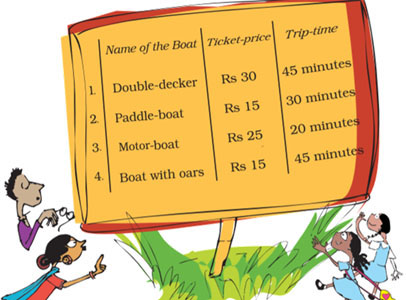
Step 1: The cost of motor-boat is Rs 25 for 20 minutes. Add 25 twice to get the amount paid by Indra and Bhanu for the motor-boat.
25 + 25 = 50
Step 2: The cost of oar-boat is Rs 15 for 45 minutes. Add 15 twice to get the amount paid by them for the oar-boat.
15 + 15 = 30
Step 3: Add 50 and 30 to get the total amount paid by them for both the boats.
50 + 30 = 80
Therefore, they paid Rs 80 for both the boats.
Step 4: Time taken in motor-boat ride is 20 minutes. Time taken in oar-boat ride is 45 minutes. Add 20 and 45 to get total time taken in both the rides.
20 + 45 = 65
Therefore, they get 65 minutes for both rides.
Which boat makes two trips in 1 hour?
The relation between hour and minute is 1 hour = 60 minutes.
The paddle-boat takes 30 minutes in one trip. Therefore, the paddle- boat makes two trips in 1 hour.
Which boat takes less than half an hour to complete a trip?
Half an hour is equal to 30 minutes.
The motor-boat takes 20 minutes which is less than 30 minutes. Therefore, the motor-boat takes less than half an hour to complete a trip.
Which boat gives them the most time taking the least money?
The cost of paddle-boat is Rs 15 for 30 minutes and the cost of oar- boat is Rs 15 for 45 minutes. Both the paddle-boat and the oar-boat takes Rs 15 for a trip but the oar-boat gives a longer time.
Therefore, the oar-boat gives them the most time taking the least money.
Javed went twice for boating. He paid a total of Rs 40 and boated for 50 minutes. Which two boats did he take?
The cost of motor-boat is Rs 25 for 20 minutes and the cost of paddle- boat is Rs 15 for 30 minutes.
Step 1: Add 25 and 15 to get the total cost.
25 + 15 = 40
Step 2: Add 20 and 30 to get the total time.
20 + 30 = 50
Step 3: The amount required for the motor-boat and the paddle-boat ride is Rs 40 and time taken is 50 minutes. Therefore, Javed went for motor-boat and the paddle-boat.
So, they should reach Hoshangabad by ______ o’clock.
Time taken to reach Hoshangabad is 2 hours. They will start it at 4 o’clock. Therefore, they will reach at around 6 o’ clock.
Have you ever been on a school trip? How many children were there in all? How did you go and how far? How much time did it take? Try to find out the cost of travel for each child.
If you have ever gone on a school recollect the memories and answer all the questions
There are four very old cave-paintings. Mark the oldest.
a) 4200 years old
b) 1000 years old
c) 8500 years old
d) 1300 years old
In the given option the oldest cave-painting is of 8500 years old. Therefore, the option c is the correct answer.
One bus can carry 48 children. How many children can three busses carry? About-
a) 100
b) 200
c) 150
Number of children one bus can carry is 48. Multiply 48 by 3 to get the number of children that three buses can carry.
48 × 3 = 144
Therefore, three buses can carry 144 children which is approximately 150 children. Hence, the option c is the correct answer.
Which pair of numbers add to make more than 500?
a) 152 and 241
b) 321 and 192
c) 99 and 299
d) 401 and 91
Step 1: Add 152 and 241 to check if the sum is more than 500.
152 + 241 = 393
Step 2: Add 321 and 192 to check if the sum is more than 500.
152 + 241 = 513
The sum of 321 and 192 is 513 which is more than 500. Therefore, the option b) is the correct answer
What happened at what time? Draw lines to match.
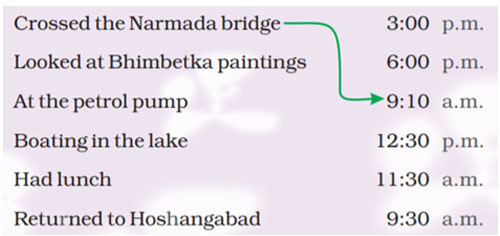
Draw a line to match the event with the correct times
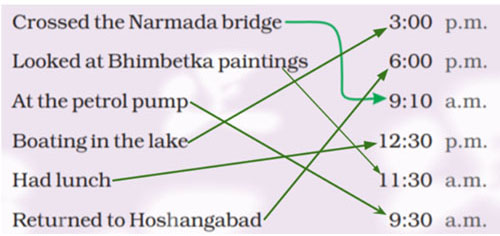
One group of children went for the double- decker trip. They paid Rs 450 in total. How many children went for the double-decker trip?

The cost of double-decker boat is Rs 30. Amount paid by the group of children is Rs 450.
Divide 450 by 30 to get the number of children.
450 ÷ 30 = 15
Therefore, 15 children went for the double-decker trip.

Admissions Open for 2025-26
Frequently Asked Questions
The NCERT solution for Class 4 Chapter 3: A Trip to Bhopal is important as it provides a structured approach to learning, ensuring that students develop a strong understanding of foundational concepts early in their academic journey. By mastering these basics, students can build confidence and readiness for tackling more difficult concepts in their further education.
Yes, the NCERT solution for Class 4 Chapter 3: A Trip to Bhopal is quite useful for students in preparing for their exams. The solutions are simple, clear, and concise allowing students to understand them better. They can solve the practice questions and exercises that allow them to get exam-ready in no time.
You can get all the NCERT solutions for Class 4 Maths Chapter 3 from the official website of the Orchids International School. These solutions are tailored by subject matter experts and are very easy to understand.
Yes, students must practice all the questions provided in the NCERT solution for Class 4 Maths Chapter 3: A Trip to Bhopal as it will help them gain a comprehensive understanding of the concept, identify their weak areas, and strengthen their preparation.
Students can utilize the NCERT solution for Class 4 Maths Chapter 3 effectively by practicing the solutions regularly. Solve the exercises and practice questions given in the solution.

